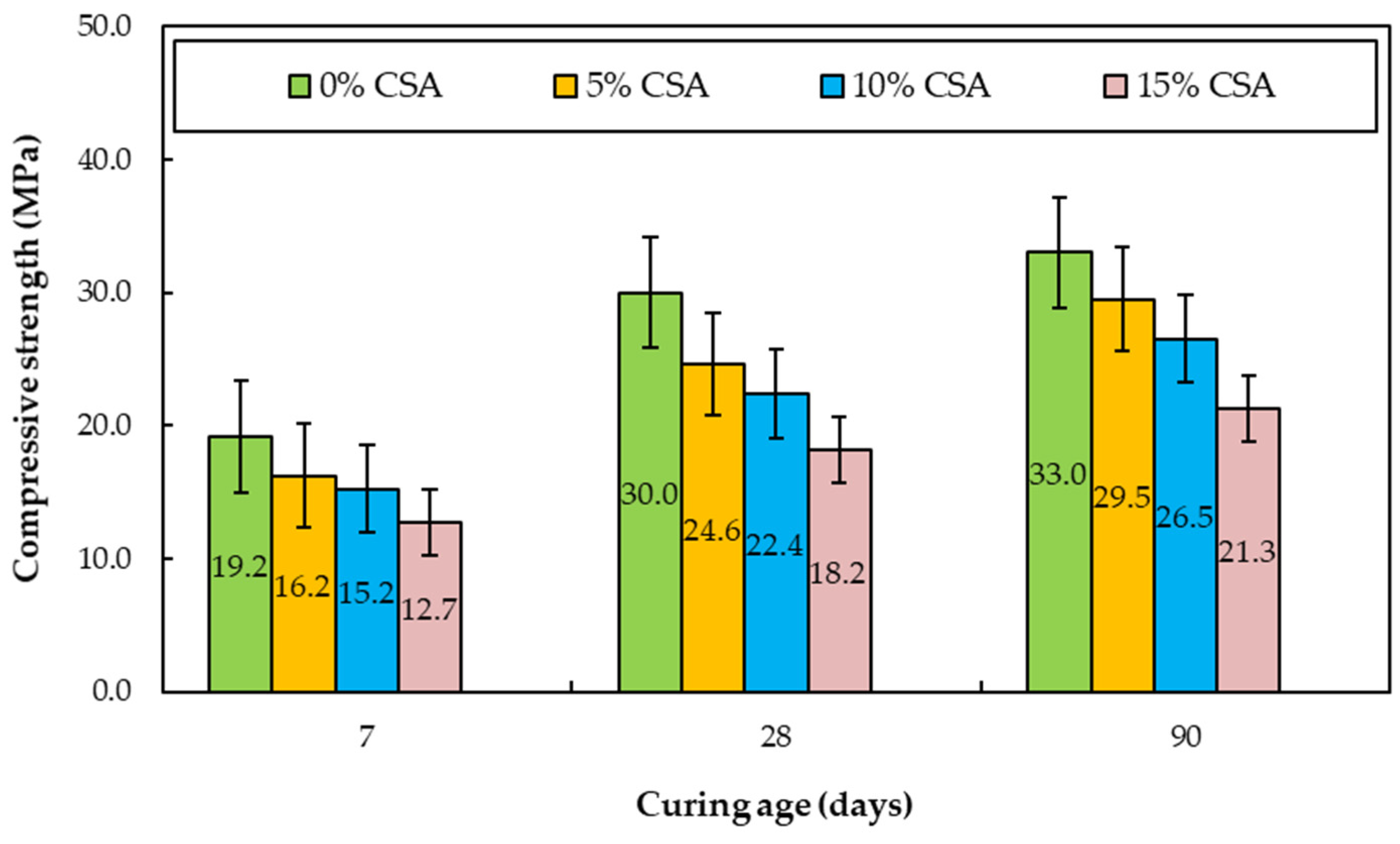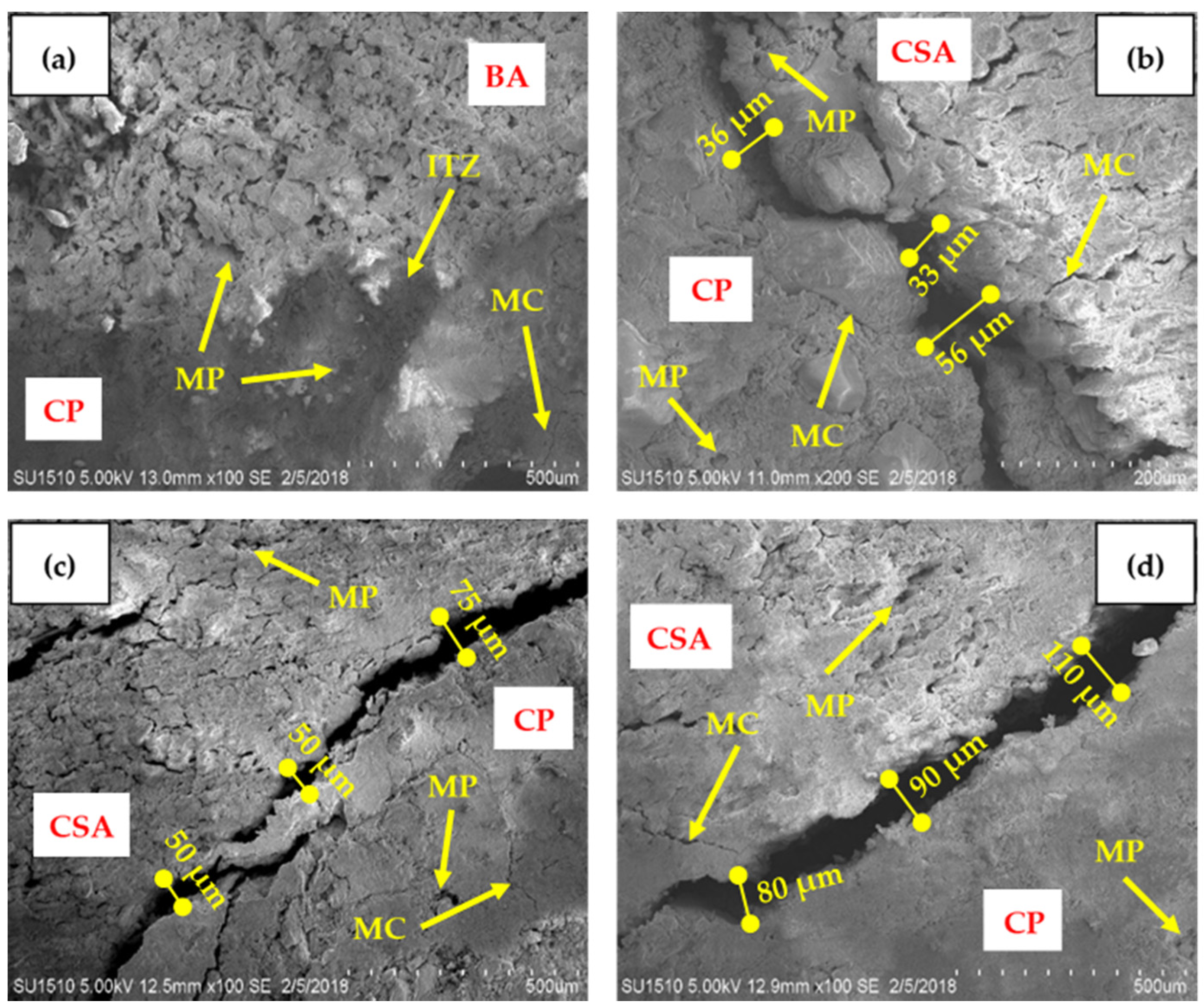1. Introduction
The costs of building materials are going up gradually. In addition, the amount of waste materials generated from agricultural and industrial sectors is increasing enormously all over the world. Coconut shell (CS) is one among these wastes—it is generated from fully ripe coconuts. Around 62 million tons of coconuts are produced every year in the world, including Bangladesh [
1]. CS comprises around 15.6% of the whole fruit [
2]. Consequently, about 9.7 million tons of CS are obtained from the coconut fruit per year. The disposal of such a huge amount of CS has become a real problem, which could be alleviated if it can be utilized in producing construction materials. CS can be used in concrete as a partial replacement of conventional coarse aggregate, thus reducing the cost of concrete production and resolving the disposal problem caused by coconut waste.
Many researchers investigated the use of CS aggregate (CSA) in normal-weight concrete [
3,
4,
5,
6,
7,
8,
9]. Reddy et al. [
3] produced several concretes substituting 25%, 50%, and 100% of natural coarse aggregate (NCA) by CSA. The effects of CSA on the workability and strength properties (compressive strength, splitting tensile strength, and flexural strength) of concrete were examined by them. The respective 28-day compressive strength of the concrete mixes with 25%, 50%, and 100% CSA was 22.26 MPa, 14.93 MPa, and 5.48 MPa in their study. They also showed that about 4.45%, 8.90%, and 17.81% of the cost can be reduced for 25%, 50%, and 100% CSA, respectively. Ranjith [
4] used CSA as a 100% replacement of conventional granite aggregate in concrete using two sets of mix proportions and conducted tests for compressive strength, flexural strength, and modulus of elasticity. He found the 28-day compressive strength of CSA concretes in the range of 17.73–21.33 MPa. Abubakar and Abubakar [
5] incorporated CSA into concrete replacing 100% NCA (gravel) with the volumetric mix ratios of 1:1.5:3, 1:2:4, and 1:3:6 (cement: fine aggregate: coarse aggregate). They showed that about 48% of the cost can be reduced when CSA is used wholly as the coarse aggregate. Moreover, the cube compressive strength at 28 days was found as 16.5 MPa, 15.1 MPa, and 11.0 MPa for these three concrete mixes with 100% CSA. Rajeevan and Shamjith [
6] used CSA as 5%, 10%, 15%, 20%, 25%, 30%, and 35% replacements of NCA to produce conventional concretes. They determined the compressive strength, splitting tensile strength, and flexural strength of CSA concretes. In their study, the 28-day compressive strength of CSA concretes was found in the range 20.4–24.6 MPa. They observed that a compressive strength comparable to that of conventional concrete can be obtained using up to 15% CSA. Kamal and Singh [
7] produced several normal-weight concretes using CSA as 10%, 20%, and 30% replacements of NCA along with 0% and 20% fly ash as a partial replacement of cement. They tested the concretes for workability, density, and strength properties (compressive strength, splitting tensile strength, and flexural strength). In their study, the 28-day compressive strength was found in the range of 20.12–34.10 MPa for the CSA concretes with 0% fly ash whereas the CSA concretes including 20% fly ash had the compressive strength of 19.58–24.52 MPa. Furthermore, Patel et al. [
8] used CSA in several concretes replacing 10%, 20%, and 30% NCA. They also found that the replacement of NCA by CSA up to 20% provided a good compressive strength as compared to conventional concrete. In another study, Mohapatra and Parhi [
9] prepared multiple concretes using 5%, 10%, 15%, and 20% CSA in place of NCA. They examined the compressive strength and splitting tensile strength of CSA concretes. In their study, the respective compressive strength at 28 days was 20.67 MPa, 17.22 MPa, 16.04 MPa, and 15.45 MPa for 5%, 10%, 15%, and 20% CSA concretes. All the above studies revealed that a normal-weight concrete with adequate strength can be produced using CSA.
CSA has also been used as a lightweight coarse aggregate to produce structural lightweight concrete (SLWC) [
10,
11,
12,
13]. In 2008, Gunasekaran et al. [
10] made lightweight concretes using 100% CSA as coarse aggregate. For the CSA concretes, they obtained the dry density of 1880–1930 kg/m
3 and the compressive strength of 19.1 MPa at the age of 28 days. In another study, Gunasekaran et al. [
11] investigated the physical and mechanical properties of multiple concretes made with CSA. In their study, the density of the CSA concretes at 28 days was less than 2000 kg/m
3 and satisfied the requirement of SLWC [
14]. In addition, the 28-day compressive strength values were found as 26.70 MPa and 25.95 MPa for two different concrete mixes made with 100% CSA. Again in 2012, Gunasekaran et al. [
12] performed a long-term study on the SLWC made with CSA. They investigated the workability, density, strength properties (compressive strength and bond strength), and microstructural characteristics of CSA concretes. The dry density at 28 days was found as 1970 kg/m
3. They also observed that most of the compressive strength development took place at the early stages although it continued to increase with the increased age of concrete. In addition, Duna and Musa [
13] made multiple concretes replacing 10%, 20%, 40%, 60%, 80%, and 100% NCA by CSA. They investigated the effects of CSA on the workability, density, and strength properties (compressive strength and flexural strength) of concrete. In their study, the density and compressive strength of the CSA concretes at 28 days varied in the range of 1407–2065 kg/m
3 and 8.12–19.28 MPa, respectively. Recently, Prakash et al. [
15] developed several concretes incorporating 10–30% fly ash along with 50% and 100% CSA. They found that all the concrete mixes fulfilled the density requirement of SLWC, except the 50% CSA mix without fly ash. Furthermore, the concrete mixes with 50% CSA and 10–30% fly ash provided higher workability and strength properties (compressive strength and splitting tensile strength) than all 100% CSA mixes. The above studies infer that SLWC with acceptable strength properties can be made using CSA as a partial replacement of NCA. However, it should be mentioned that none of the above studies used brick aggregate (BA) partially or fully as the coarse aggregate in concrete.
Several studies were performed to produce brick aggregate concrete (BAC) [
16,
17,
18,
19,
20,
21]. In 1983, Akhtaruzzaman and Hasnat [
16] introduced crushed brick as coarse aggregate for use in concrete; the key mechanical properties (compressive strength, splitting tensile strength, flexural strength, and modulus of elasticity) of various BACs were examined in their study. They found the 28-day compressive strength of BACs in the range of 16–38 MPa. Mansur et al. [
17] investigated the suitability of using crushed brick as the coarse aggregate in concrete by investigating its basic properties (workability, compressive strength, flexural strength, splitting tensile strength, modulus of elasticity, stress-strain relationship, drying shrinkage, and creep). They produced BACs with a compressive strength ranging from 64 MPa to 72 MPa at the age of 28 days. Cachim [
18] produced concretes with crushed brick and investigated their workability, density, and mechanical properties (compressive strength, splitting tensile strength, and modulus of elasticity). They found the 28-day compressive strength of 24.5–32.3 MPa for different BAC mixes. Rashid et al. [
19] used BA in concrete replacing 25%, 50%, 75%, and 100% of NCA. They examined the effects of BA on the density and mechanical properties (compressive strength, splitting tensile strength, flexural strength, and modulus of elasticity) of concrete. For different BACs, they obtained the compressive strength of 31.11–45.50 MPa at 28 days. Again, Rashid et al. [
20] conducted another study to produce high strength concrete using BA. They examined the density and mechanical properties (compressive strength, flexural strength, and modulus of elasticity) of various BACs. In their study, the respective 28-day compressive strength of BAC was 25.04, 24.63, 19.89, and 18.29 MPa for 25%, 50%, 75%, and 100% replacement of NCA. Furthermore, Noaman et al. [
21] investigated the workability and mechanical properties (compressive strength, splitting tensile strength, flexural strength, modulus of elasticity, and Poisson’s ratio) of BAC containing rice husk ash as a partial replacement of cement. They found that the compressive strength of BAC at 28 days varied in the range of 21.5–30.9 MPa. It was also observed that some of the BACs produced in the above studies satisfied the density requirement of SLWC given by ACI Committee 213 [
14]. However, none of these studies incorporated CSA into BAC as a partial replacement of BA and investigated the effects of CSA on the properties of concrete.
In this study, CSA was used as a partial replacement of BA to produce coconut shell brick aggregate concrete (CSBAC). The workability (slump), wet density, air content, dry density, compressive strength, and microstructure of various concrete mixes including 0–15% CSA were examined. The effect of microstructure on the compressive strength of CSBAC was sought. In addition, the fissure width in the interfacial transition zone (ITZ) of CSBAC was measured. The relationship between the fissure width and compressive strength of CSBAC was also derived.
5. Sustainable Benefits of Using CSA in Concrete
Rapid industrialization in the world is increasing the quantity of waste materials day by day, thus creating environmental hazards due to uncontrolled disposal. Among the agricultural wastes, large quantities of CS solid waste from de-husked coconuts are generated in the tropical countries of the world. Each year, about 62 million tons of coconuts are produced and distributed throughout the world [
1]. A huge amount of CS waste (about 9.7 million tons per year) is being generated from these coconuts. Particularly, CS waste is generated abundantly in coconut-producing countries, such as Bangladesh and Sri Lanka. After the coconut meat (pulp) is scraped out, the shell is typically discarded as waste in open fields. The vast amount of this discarded CS creates serious disposal and environmental problems due to its non-biodegradable nature. Such issues can be resolved if CS is utilized in construction industry.
Attempts have been made to utilize the CS waste as a replacement of aggregate material in the construction industry, especially to produce concrete, for the sake of sustainable development in developing countries. Furthermore, if CS is used in concrete as coarse aggregate, at least partially, it would compensate the scarcity of natural aggregates. It could be accomplished without significantly affecting the properties of concrete. Past research showed that the concretes made incorporating CS as a partial replacement of coarse aggregate can provide satisfactory workability and reasonably good compressive strength, bond strength, and impact and crushing resistance [
11,
12]. CSA concrete has already been used to some extent in rural areas and other places where CS is generated abundantly or NCAs are costly due to their scarcity [
6,
11,
12,
59].
In the construction industry, the use of coarse aggregates from natural sources should be reduced and alternative materials, such as CSA, need to be used as a substitute of natural aggregate for sustainable development. The increasing consumption of NCA creates an ecological imbalance, which can be alleviated by using alternative sources of coarse aggregate in the construction industry. Furthermore, in certain regions, such as Bangladesh and West Bengal (India), natural rock deposits are scarce. In these regions, burnt-clay bricks are crushed to produce BA, which is used as an alternative of NCA. In Bangladesh, BA is commonly used as coarse aggregate for the construction of rigid pavements, small- to medium-span bridges, culverts, and low-rise buildings [
16,
17,
20]. However, the brickkilns are one of the sources of CO
2 emissions that cause air pollution. In addition, the huge quantity of bricks produced for use as masonry units and in making BA for construction work is causing the overexploitation of clay soils. These environmental problems can also be lightened if CSA is used to reduce the consumption of BA in concrete.















